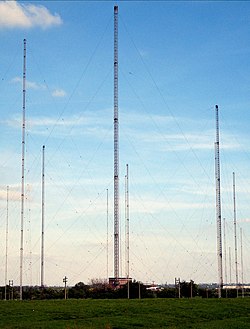Rugby transmitting station

A view of the tallest masts
|
|
| Location | Hillmorton, Rugby, Warwickshire |
|---|---|
| Mast height | 250 metres (820 ft) |
| Coordinates | 52°21′57″N 1°11′21″W / 52.36577°N 1.18928°WCoordinates: 52°21′57″N 1°11′21″W / 52.36577°N 1.18928°W |
| Grid reference | SP5519574542 |
| Built | 1926 |
| Demolished | 2007 |
Rugby Radio Station was a radio transmission facility at Hillmorton near the town of Rugby, Warwickshire in England, situated just west of the A5 trunk road and in later years junction 18 of the M1 motorway. Its large very low frequency (VLF) transmitter came into service on 1 January 1926 and was originally used to transmit telegraph messages to the Commonwealth as part of the Imperial Wireless Chain. After the 1950s this transmitter, active as callsign GBR on 16.0 kHz, using Morse code and later on 15.975 kHz with frequency-shift keying FSK and minimum-shift keying MSK, was used for transmitting messages to submerged submarines. Criggion radio station acted as a reserve. The GBR transmitter was shut down on 1 April 2003 and was replaced by a new one at the Skelton transmitting station.
In 1927, a second transmitter was installed to initiate the first transatlantic commercial telephone service; linking New York and London on 60 kHz using single-sideband modulation. This transmitter was decommissioned in 1956 and became the time signal transmitter MSF. This new function developed from the decision, in 1951, to use the station to transmit modulated standard frequencies for scientific reference purposes. In 1972 these transmissions were consolidated onto the present frequency of 60 kHz and a further reference, that of a time signal, was added. In 1977 this took the form of the rolling slow code in use until April 2007, when BT's contract to transmit the time signal also passed to VT Communications, using their Anthorn radio station in Cumbria.
...
Wikipedia

